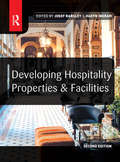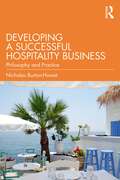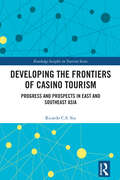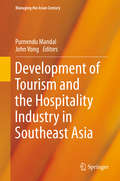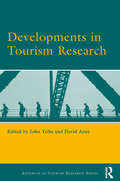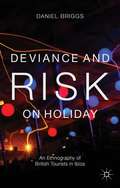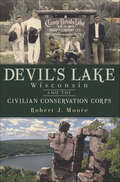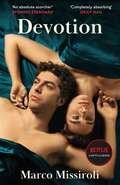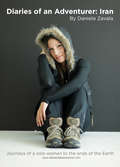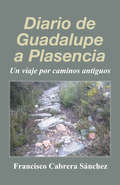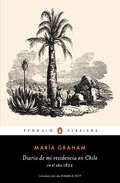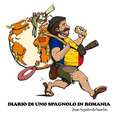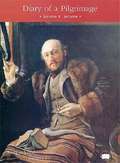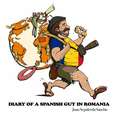- Table View
- List View
Developing Age-Friendly Communities in the UK: Re-creating Places and Spaces
by Stephen J. Page Joanne ConnellThe ageing population is a global societal issue. Policymakers, planners and the public, third and private sectors must rethink how the built environment and services are delivered to meet the needs of a changing demographic. This is the first book to systematically review the evolution, development and progress of age-friendly thinking in the UK, with a primary focus on the real-world experiences of the people leading place-based initiatives. The book presents the findings of the first in-depth national study of age-friendly programme leaders in the UK, completed in 2021, and provides insights into the development of age-friendly communities, the formative influences from a social policy perspective, the management challenges and the progress towards achieving age-friendly goals. Using primary interview data and narrative analysis, the experiences of working with age-friendly programmes in different organisational forms are explored. The book promotes a greater understanding of what it means to become an age-friendly community in practice, how the programmes have different development pathways, and what influences different outcomes. Embellished with detailed narratives from practitioners, informative tables, and diagrams and figures throughout, the book carefully gathers the voices of a diverse range of decision-makers and leaders associated with the age-friendly movement and provides unique insights on the drivers of change in specific localities. This is a must-read for anyone involved in ageing research or ageing policy and practice as it provides an insightful look into the real world of embedding this community development model in different localities to make a difference to the lives of older people. Topical themes include how these agendas connect with other issues, such as dementia-friendly programmes and the work of the third sector, as well as the growing challenge of what it means to be ‘friendly’ as a community and place and whether ‘friendly’ is becoming an over-used term in relation to place identity. The book has national and global interest for all communities engaged in age-friendly activity, offering exemplars of best practice, achievements in transforming local communities and views on the meaning of ageing, as well as the age-friendly lens as an approach that champions the world through the eyes of older people. It offers a thought-provoking read for anyone with an interest in this expanding area of ageing, irrespective of disciplinary focus.
Developing Hospitality Properties and Facilities
by Josef RansleyIn light of the tumultuous global changes which have dramatically affected the hospitality business, the third edition of Developing Hospitality Properties and Facilities provides insight into the reality of developing hospitality properties in challenging international contexts. Since its successful first publication in 2000 and subsequent second edition in 2004, Developing Hospitality Properties and Facilities has sought to model and demystify the process of designing, planning, constructing and sustaining hospitality properties. The third edition boasts an impressive array of academic and professional contributors from Europe, North America, South America, Asia, Africa and the Middle East and 12 case studies and issues concerning individual hotels and international regions and addressing issues of technology, revenue management and fee structures. This edition recognizes that in order for the hospitality sector to overcome periodic problems such as global pandemics, it is important to inform academic and professional readers so that they can ensure that future developments are sustainable, environmentally friendly and resilient in the longer term. Written for hospitality owners, developers, investors and managers and suitable for students, this book aims to bridge the gap between generic and applied texts using a model-based approach to clarify the process in an informed, non-technical way.
Developing Hospitality Properties and Facilities (Hospitality, Leisure And Tourism Ser.)
by Josef Ransley Hadyn IngramDeveloping Hospitality Properties and Facilities sets out some of the key issues in developing hospitality properties from the hospitality manager's perspective. From the original concept, through each part of the process, it provides an essential guide for students and professionals on how to manage hospitality facilities to their best effect, using a model-based insight into the process in an informed, but non-technical way.Now in its second edition, this successful text has been updated with new international case studies from companies such as MyTravel, Disneyland Paris Hotel, Elysium Beach Resort Cyprus and many others. It also includes new chapters from well-known authors. With contributions from both academics and practitioners, this book looks at design, building issues, operational relationships, and therefore provides the hospitality manager with insight into how these areas work and what they need to know in order to get the best out of them.
Developing Industrial and Mining Heritage Sites: Lavrion Technology and Cultural Park, Greece (Routledge Insights in Tourism Series)
by Taşkın Deniz YıldızDeveloping Industrial and Mining Heritage Sites offers a multifaceted examination of the challenges and opportunities in the development of industrial & mining heritage. It does so through the case study of Lavrion, Turkey, by examining the historical process of this former mining site which has turned intoa site of industrial and cultural heritage. It explores the ruins and monuments which could be considered the industrial & mining heritage of Lavrion, the restoration, and rehabilitation of the mine buildings, and describes the activities succeeded through the management of a university and through the provided finance on an abandoned mining site. The book also highlights the challenges experienced from the restoration of an abandoned mine site until it turned into an industrial & mining heritage. This book will be of interest to researchers in the fields of industrial heritage & tourism, urban conservation, mining history, post mining, archaeology, archaeometallurgy, geology and mineralogy, as well as policy makers and industry professionals.
Developing a Successful Hospitality Business: Philosophy and Practice
by Nicholas Burton-HowatWhether dreaming of your very own guest house or remodelling a well-established business, success in hotels and hospitality requires a plan, and this book is packed full of practical advice to help you on your journey.This book offers philosophical perspectives, as well as taking a real-world approach to developing a hospitality business based around the 3P’s (Place, Purpose and Profit), utilising experience and expertise gained globally and offering useful practical insights into the successes. It looks at the methods and the psychology of decision making, communications, branding and marketing, as well as providing instruction on building a Profit & Loss account, appraising real estate opportunities, developing your project and asset managing your investment. These multidisciplinary approaches and often complex concepts are decoded into easily digestible segments.Written by a hotel and hospitality expert with around 30 years of global experience, this book offers hospitality entrepreneurs and practitioners an important guide on getting into and surviving in the hospitality business.
Developing the Frontiers of Casino Tourism: Progress and Prospects in East and Southeast Asia (Routledge Insights in Tourism Series)
by Ricardo C.S. SiuThis book explicates how the frontiers and path of development of casino tourism in various destinations in East and Southeast Asia are shaped by a set of social, cultural, political and economic forces and their interplays in a dynamic environment, and the prospects of this industry in different destinations in the 2020s and onward.Casino tourism has been a rapidly growing industry in East and Southeast Asia in the 2000s and 2010s. By scrutinizing the respective evidence from the better-developed, emerging and potential casino tourism destinations in East and Southeast Asia (which include Macao, Singapore, Malaysia, South Korea, the Philippines, Vietnam, Cambodia, Myanmar, Japan, Thailand and Taiwan), the book analyses specific contextual dimensions, including social, cultural, political and economic standpoints; the pragmatic features associated with the progress of this industry; and performances of casino tourism at the various East-Southeast Asian casino tourism destinations. Additionally, it also explores the impacts of the “China factor” and the resultant changes to the development frontiers of casino tourism. Thus, readers who would like to gain realistic insights into the underlying forces and dynamics of the practices and prospects of this industry will find this book informative and compelling.This book provides a comprehensive and succinct reference to students and industry practitioners in the areas of tourism, casino gaming and integrated resorts who wish to gain further insights into the general and essences, business routines and prospects of casino tourism development in East-Southeast Asia. Academics may also find this book a useful source for further exploration.
Development of Tourism and the Hospitality Industry in Southeast Asia
by Purnendu Mandal John VongThis book highlights the state-of-the-art tourism and hospitality industry in Southeast Asian countries, while also presenting future directions for the industry with an emphasis on decision-making models. It first elaborates on the significant role of the tourism and hospitality industry given the rapid socio-economic and cultural changes occurring in Southeast Asia, before providing perspectives on medical tourism, tourism for seniors and several other developments within the tourism and hospitality sector. Development of Tourism and the Hospitality Industry in Southeast Asia presents scholarly perspectives from researchers across the region and is geared towards world-wide readers in academia, as well as experts from the industry.
Developments in Tourism Research (Advances in Tourism Research)
by John Tribe David AireyThis book aims to be a showcase for cutting edge research offering a high-edited selection of the best paper submitted to the 2006 tourism conference at the University of Surrey, which itself is a celebration of 40 years of tourism education at the University. The emphasis of the book is on contributions which offer new insights and approaches to tourism research rather than case studies or applications of existing research methods to new contexts, and this is where the book is unique.
Deviance and Risk on Holiday
by Daniel BriggsThis book represents the first attempt to step inside the holiday experience of young British tourists in San Antonio, Ibiza. Briggs' ethnographic study reveals the ugly truth about how and why they get involved in deviance and risk-taking when they go abroad, driven by self validation and a commodified social context.
Devil's Lake, Wisconsin and the Civilian Conservation Corps
by Robert J. MooreThousands of young men embarked on the adventure of a lifetime when they joined the Civilian Conservation Corps during the Great Depression.Service at Wisconsin's popular state park offered notoriety absent at most camp assignments. While most of the CCC work around the country was in remote forests and farmlands, at Devil's Lake tourists could view CCC project activity each day, forging that labor into an essential part of the park experience. Historian Robert J. Moore interviews veterans and mines the archives to preserve this legacy so that the gasps of wonder at nature's marvels remain mixed with respect for the men who helped bring them forth.
Devil's Teeth: A True Story of Obsession and Survival Among America's Great White Sharks
by Susan CaseyFrom the book jacket... Travel thirty miles north, south, or east of San Francisco city hall and you'll be engulfed in a landscape of thick traffic, fast enterprise, and six-dollar cappuccinos. Venture thirty miles due west, however, and you will find yourself on what is virtually another planet: a spooky cluster of rocky islands called the Farallones, battered by foul weather, thronged with two hundred thousand seabirds, and surrounded by the largest great white sharks in the world. Journalist Susan Casey was in her living room when she first glimpsed this strange place and its resident sharks, their dark fins swirling around a tiny boat in a documentary. These great whites were the alphas among alphas, the narrator said, some of them topping eighteen feet in length, and each fall they congregated here off the northern California coast. That so many of these magnificent and elusive animals lived in the 415 area code, crisscrossing each other under the surface like jets stacked in a holding pattern, seemed stunningly improbable-and irresistible. Casey knew she had to see them for herself.
Devotion: Soon a Netflix limited series
by Marco MissiroliNOW A NETFLIX LIMITED SERIES, COMING VALENTINE'S DAY 2022 'An absolute scorcher' Evening Standard'The book about infidelity that has shaken up Italy'The Times'Intimate and ultimately moving... completely absorbing'Daily Mail'A gripping novel exploring the tensions in an apparently idyllic marriage' Financial Times 'A must-read'Sydney Morning Herald'Devotion thrilled me, made me think and moved me deeply... Irresistible'Jonathan Safran FoerCarlo, a part-time professor of creative writing, and Margherita, an architect-turned-real estate-agent: a happily married couple in their mid-thirties, perfectly attuned to each other's restlessness. They are in love, but they also harbour desires that stray beyond the confines of their bedroom: Carlo longs for the quiet beauty of one of his students, Sofia; Margherita fantasises about the strong hands of her physiotherapist, Andrea.But it is love, with its unassuming power, which ultimately pulls them from the brink, aided by Margherita's mother Anna, the couple's anchor and lighthouse - a wise, proud seamstress hiding her own disappointments.But after eight years of repressed desires and the birth of a son, when the past resurfaces in the form of books sent anonymously, will love be enough to save them? A no. 1 international bestsellerWinner of the Premio Strega GiovaniShortlisted for the Premio Strega'Powerful, delicate, exquisite' Claudio Magris 'Masterful... The ending is just as good as that of Joyce's The Dead' Corriere della Sera'You'll feel like taking refuge in this book and never leaving its confines' La Stampa'With all-encompassing writing, Marco Missiroli opens the rooms of his characters and the streets of Milan, the thoughts and the concealed desires, makes dialogue and silences reverberate with the spontaneity of great narrators' Il Foglio
Diamond Bar
by City of Diamond Bar Diamond Bar Historical SocietyAs with many Southern California communities, Diamond Bar's recorded history began with a Spanish land grant. One of the area's first settlers was Jose de la Luz Linares, who founded Rancho Los Nogales (Ranch of the Walnut Trees) on the 4,340 acres granted to him by Mexican governor Juan Alvarado in 1840. The grant included Brea Canyon and the eastern Walnut Valley, a portion of which became the Diamond Bar Ranch, founded by Frederick E. Lewis II in 1918. In 1956, the area looked much as it did in 1840, its golden hills peppered with green stands of oak and walnut trees and grazed by large herds of cattle. In that year, the Transamerica Corporation paid $10 million for 8,000 acres of Brea Canyon, with plans to construct Southern California's largest master-planned community and name it Diamond Bar. Incorporated on April 18, 1989, the city of Diamond Bar is home to nearly 55,000 residents and is located at the crossroads of the Orange (57) and Pomona (60) Freeways on the eastern edge of Los Angeles County.
Diaries of an Adventurer: "Journeys of a solo woman to the ends of Earth"
by Daniela ZavalaMixing current events, culture, adventure, history, humor and high doses of adrenaline, "Diaries of an Adventurer" series is a close and authentic look at remote societies and controversial countries around the world. In each travelogue, journalist, and intrepid adventurer Daniela Zavala immerses herself with ceaseless curiosity into exotic cultures and dangerous destinations that can only be comprehended with an open mind, easiness and never-ending inquisitiveness. Since 1997, Daniela has visited solo over 70 countries without fear or prejudice, exploring places that most people wouldn't dare to go or might not even know about. In this edition, Daniela ventures to Iran just a few months after the controversial 2009's presidential election. This land rich in culture has been polemic and feared by the Western world. But, how is the Islamic Republic really like? What's in the mind of the average Iranian? Daniela's experience brings you closer to this fascinating and so-talked about nation.
Diario de Guadalupe a Plasencia: Un viaje por caminos antiguos
by Francisco Cabrera SánchezUn viaje para conocer, yendo andando, los campos cacereños, a sus paisajes, a sus gentes y sus cosas, para reflexionar sobre nuestra vida más cotidiana, de forma tranquila, con humor y un poquito de historicismo. <P><P>El Diario de Guadalupe a Plasencia es la narración de un periplo a pie por las comarcas cacereñas de las Villuercas, los Ibores, Campo Arañuelos y Monfragüe que nos da a conocer unos parajes naturales singulares, con sus sierras agrestes y caminos antiguos, abandonados hoy por el uso de los coches y las carreteras, describiendo de manera fluida y amena los paisajes, los pueblos y las gentes que viven en ellos y su historia. <P>Un recorrido en el que, cual Ulises en su vuelta a Ítaca, el autor nos transmite el placer del viajar por viajar, del andar por el campo, de su deseo de conocer e intentar que el viaje sea largo, para que no tengamos ganas de acabarlo nunca. <P> Y, como Don Quijote, imagine por donde va historias y tiempos que ya no son o épocas idílicas que quizás nunca fueron. <P>Para parodiar a veces nuestra sociedad, tan llena de complejos y contradicciones, invitándonos de una forma amena y divertida a reflexionar sobre cuestiones controvertidas unas o ancladas en los tópicos otras. <P>Todo ello contado de una forma sencilla y llena de humor, como si de un cuaderno de bitácora se tratara, como recordatorio del viaje y un legado de experiencias y reflexiones para los lectores.
Diario de mi residencia en Chile: en el año 1822
by Maria GrahamDocumento invaluable de los años de formación de la república. El diario de una viajera y naturalista inglesa que se instaló en Valparaíso y viajó por el valle central describiendo las costumbres, los paisajes, la vegetación. La primera mirada femenina de Chile. Viajera y naturalista inglesa, María Graham decide quedarse en Valparaíso un año, después de enterrar en el puerto el cuerpo de su marido, un marino inglés fallecido en el mar, camino a Chile. Durante este tiempo escribe en su diario sus experiencias, cientos de observaciones de paisajes y plantas que conoce y observa, las costumbres de los chilenos, sus amistades -entre ellas Bernardo O'Higgins y Lord Cochrane- las formas de vivir, las artesanías, las bebidas y comidas, y emprende un viaje por el valle central en donde conocerá y describirá en estas páginas Santiago, Colina, Pudahuel, Talagante, El Monte, Viluco, Quinteros, Con Con, entre otros. A cada uno de estos lugares, Graham le dedica exquisitas descripciones, observaciones de sus habitantes y sus costumbres, sus vestimentas y especialmente los árboles, plantas y flores que le fascinaron. Por primera vez en castellano, esta edición incluye los dibujos de María Graham que fueron publicados en su edición original en Londres en 1823. Y un prólogo de Diamela Eltit, Premio Nacional de Literatura. Una edición completa, con los grabados y viñetas, nunca antes publicada en castellano.
Diario de mis vacaciones (¡Arriba la Lectura!, Level E #27)
by Annette Smith Lyz Turner-Clark Rachel TonkinNIMAC-sourced textbook. Fui de vacaciones a la casa de mi abuelo. Nos divertimos mucho en la playa. ¿Quieres leer mi diario?
Diario di uno spagnolo in Romania
by Juan Sepulveda Sanchis Cecilia BadialiLe avventure di uno spagnolo in viaggio in Romania. In questo capitolo del diario di uno spagnolo in viaggio nel mondo ci troviamo coinvolti in un programma strutturato affinchè i giovani europei cooperino e assumino un ruolo attivo nella società. In questo viaggio però ci troviamo ben lontani dalla realtà: con uno stile sarcastico e divertente scopriamo la Romania attraverso gli occhi di un gruppo di giovani europei, più preoccupati per il divario culturale e la ricerca dell'amore che per assumere il comando della società.
Diarios de viaje
by Albert CamusLas imborrables impresiones que registró Albert Camus en sus viajes por América del Norte y América del Sur durante los años cuarenta Publicado a título póstumo en 1978, Diarios de viaje contiene los apuntes que Albert Camus tomó durante dos periplos por América del Norte y América del Sur en los años cuarenta. Una primera parte describe su estancia en los Estados Unidos y Canadá de marzo a mayo de 1946, mientras que la segunda recoge su paso por el Brasil, la Argentina y Chile entre junio y agosto de 1949. Aunque presentan un interés común, los textos tienen un tono muy distinto. Camus llega a dar conferencias en Estados Unidos como un periodista de la resistencia y autor poco conocido; en Sudamérica, en cambio, desembarca en viaje oficial, como el escritor consagrado por el éxito mundial de La peste. El segundo viaje también le depara los temores vinculados al recrudecimiento de la tuberculosis que lo acosaba desde su juventud. Y en sus páginas queda la marca de una crisis personal de la que nacerán nuevas obras.
Diary of a Pedestrian in Cashmere and Thibet
by W. H. KnightNothing could exceed the beauty of the view as we approached our intended halting-place. Having crossed the torrent by a wooden bridge, the mountains we had been winding through showed out in all their grandeur, while above us, inaccessible peaks, with sharp and fanciful projections, nestled their mighty heads among the fleecy clouds, which hung about after the recent rains. ~ ~ ~ Captain William Henry Knight journeyed through Kashmir and Tibet in 1860 in the company of another officer and a porter. Having spent a year and a half in India with his regiment, Captain Knight had managed to obtain a six months' leave of absence in order to escape the hot season and journey through the cool foothills of the Himalayas. His goal in this volume was to represent "a faithful picture of travels in regions where excursion trains are still unknown, and Travelers' Guides unpublished." WILLIAM HENRY KNIGHT was a Captain in England's Forty-Eighth Regiment. This is his only known work.
Diary of a Pilgrimage
by Jerome K. JeromeWhile it is beyond doubt that Jerome K. Jerome is most well known for his comic masterpiece Three Men in a Boat, the range of his other literary achievements is staggering. Journalist, playwright and author, a wealth of his writing has remained just beyond the public gaze. Diary of a Pilgrimage is one such work. The pilgrimage of the title is a journey to see the famous Passion Play at Oberammergau, which has been performed every ten years since 1634, the middle of the Thirty Years War. Diary is a typically witty account of this journey, part travelogue and part social commentary. It is also a work which has long deserved its place in the sun, outside of the benevolent shade of Jerome's more famous writing.
Diary of a Pilgrimage
by Jerome K. JeromeThis is a sensible book. I want you to understand that. This is a book to improve your mind. In this book I tell you all about Germany--at all events, all I know about Germany--and the Ober-Ammergau Passion Play. I also tell you about other things. I do not tell you all I know about all these other things, because I do not want to swamp you with knowledge. I wish to lead you gradually. When you have learnt this book, you can come again, and I will tell you some more.
Diary of a Spanish guy in Romania
by Juan Sepulveda SanchisIn this chapter of the diary of a Spanish guy traveling around the world we find ourselves within a program designed for young Europeans to cooperate and take an active role in the society. But on this trip, nothing can be more far away from the reality. With a sarcastic and entertaining style we discover Romania through the eyes of a group of young Europeans, more concerned about the culture shock and the search for love than about taking the leadership of the society.
Diary of a Tuscan Bookshop: A Memoir
by Alba DonatiUnder the Tuscan Sun meets Diary of a Bookseller in this charming memoir by an Italian poet recounting her experience opening a bookshop in a village in Tuscany.Alba Donati was used to her hectic life working as a book publicist in Italy—a life that made her happy and allowed her to meet prominent international authors—but she was ready to make a change. One day she decided to return to Lucignana, the small village in the Tuscan hills where she was born. There she opened a tiny but enchanting bookshop in a lovely little cottage on a hill, surrounded by gardens filled with roses and peonies. With fewer than 200 year-round residents, Alba&’s shop seemed unlikely to succeed, but it soon sparked the enthusiasm of book lovers both nearby and across Italy. After surviving a fire and pandemic restrictions, the &“Bookshop on the Hill&” soon became a refuge and destination for an ever-growing community. The locals took pride in the bookshop—from Alba&’s centenarian mother to her childhood friends and the many volunteers who help in the day-to-day running of the shop. And in short time it has become a literary destination, with many devoted readers coming from afar to browse, enjoy a cup of tea, and find comfort in the knowledge that Alba will find the perfect read for them. Alba&’s lifelong love of literature shines on every page of this unique and uplifting book. Formatted as diary entries with delightful lists of the books sold at the shop each day, this inspirational story celebrates reading as well as book lovers and booksellers, the unsung heroes of the literary world.
Diary of a Tuscan Bookshop: The heartwarming story that inspired a nation, now an international bestseller
by Alba DonatiHOW A BOOKSELLER INSPIRED A NATIONThe diary of a publicist-turned bookseller who left Florence to open a tiny bookshop on a Tuscan hill. 'A work of significant beauty... Inspiring about the continuing life of books, and about the ways in which our lives can change and our dreams can come true, if only we insist on believing in changes and dreams'Michael Cunningham, author of The Hours'Romano, I'd like to open a bookshop where I live.''Right. How many people are we talking about?''A hundred and eighty.''Right, so if a hundred and eighty thousand people live there, then . . .''No, not hundred and eighty thousand, Romano. Just a hundred and eighty.''Alba . . . Have you lost your mind?'Conversation between Alba Donati and Romano Montroni, founder of Italy's largest bookselling chainAlba used to live a hectic life, working as a book publicist in Florence - a life that made her happy and led her to meet prominent international authors. And yet, she always felt like she was a woman on the run.And so one day she decides to stop running and go back to Lucignana, the small village on the Tuscan hills where she was born, to open a tiny bookshop.With a total of only 180 residents, Alba's enterprise in Lucignana seems doomed from day one but it surprisingly sparks the enthusiasm of many across Tuscany - and beyond. After surviving a fire and the restrictions imposed by the pandemic, the 'Bookshop on the Hill' soon becomes a refuge and beacon for an ever-growing community of people: readers who come to visit from afar, safe in the knowledge that Alba will be able to find the perfect book for them.A tale of resilience and entrepreneurship and a celebration of booksellers everywhere: the real (and often unsung) heroes of the publishing world.


